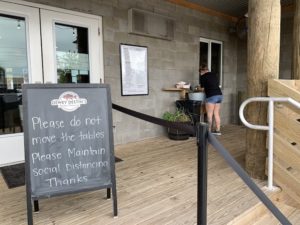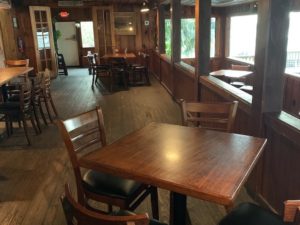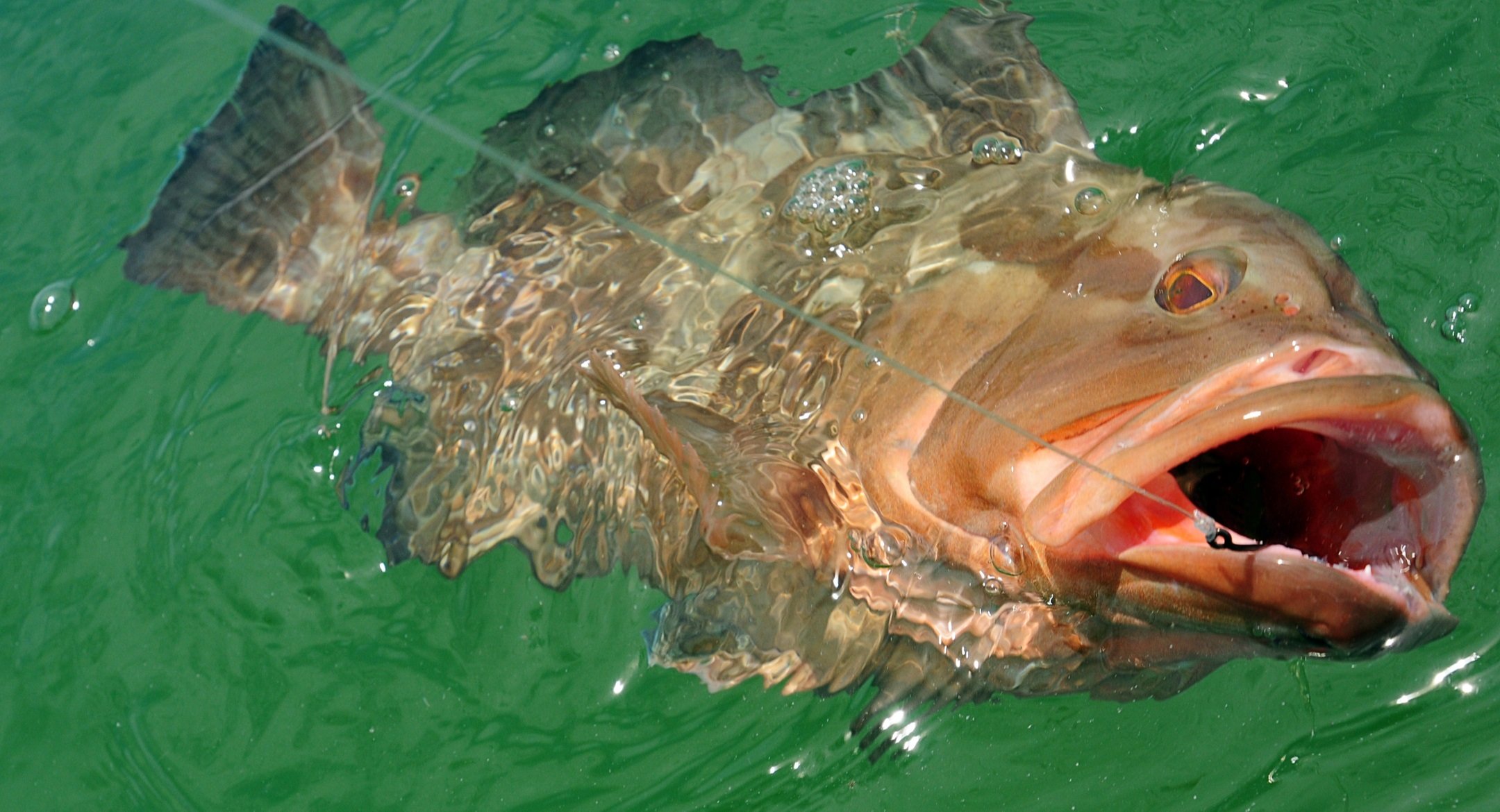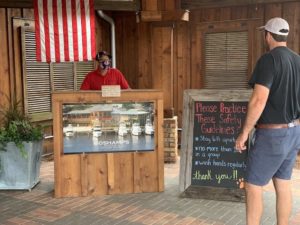This coming Memorial Day weekend is supposed to be a time of reflection in the US as the country salutes its fallen soldiers but for Dewey Destin and others in Florida’s seafood restaurant industry, it’s also a time to hustle for business as the tourists begin their annual summer invasion of the US state.
Thanks to the recent easing by Florida of its coronavirus-related restraints, Destin already is seeing an uptick in business at his three Dewey Destin’s Restaurants locations on the state’s panhandle this weekend.
“I would say the last 10 days we’ve been close to probably 80% of what it should be. So it’s looking fairly good,” the owner told Undercurrent News on Friday, adding: “As long as we don’t have a spike in people getting sick, which could put us all back to zero again.”

An outdoor hand sanitizing station at one of Dewey Destin’s Seafood Restaurants’ locations in Florida. Photograph courtesy of the Gulf Coast Seafood Alliance.
It’s a scene that will be repeated in many tourist destinations across the US over the next few days.
The United States, like other countries around the world, has slowly started to re-open its economy in time for the vacation season even as the COVID-19 pandemic continues to cause illnesses and take lives. On Thursday, another 25,506 cases and 1,314 deaths were reported in the country, driving the total numbers thus far to more than 1.6 million cases and 95,213 deaths overall.
At least 38 of the US’ 50 states have begun or set dates to ease dining restrictions, albeit with some limitations, Eater magazine reports. They range from outdoor dining only, like in Illinois starting on May 29, to states where social distancing is recommended but not enforced, like South Carolina.
The cost of the shutdown
In Florida, meanwhile, where Destin said there are 100 seafood restaurants within 10 miles of his locations, the continuing threat of the coronavirus weighs heavily. The state has had 48,675 cases and 2,144 deaths overall, including an additional 1,204 new cases and 48 deaths reported on Thursday.
Republican governor Ron DeSantis moved a week ago to further relax standards, allowing restaurants to fill 50% of their dining areas. Starting on May 4, restaurants had been limited to 25% of capacity with a requirement that tables outside be six feet apart. Florida, like a few other states, is also allowing restaurants to construct tents outside to expand their seating area, Destin noted.
Restaurants in Florida’s densely populated Miami-Dade and Broward counties, where the heaviest concentration of COVID cases can be found, meanwhile, remain closed.

In Destin, Florida, the seafood restaurant Harbor Docks prepares for lunch service on May 18 by distancing tables and reducing the seating capacity of their harbor view deck. Photograph courtesy of the Gulf Coast Seafood Alliance.
None of Destin’s three restaurants nor a fourth where the property is rented are in those two areas. Rather, he maintains two in Destin, Florida, the town named for his seven-generation seafood-oriented family, which he said settled there in the 1840s after moving from Connecticut. Dewey said he is counting grandchildren in the lineage, as he is confident they will continue the business.
When Florida closed its restaurants at the end of March, the state, which has 1,350 miles of coastline (second-most in the country), was — as highly publicized — still entertaining spring breakers, the onslaught of tourists that typically include college and high school students who have been given a week-long pause in their studies along with families who are able to escape to nicer climates with their children.
Destin estimates he lost about $500,000 worth of gross sales from each of his three restaurants during the closed period. While some restaurants have been able to pivot to take-out, he said that doesn’t make sense for his business where 80% of his patrons are from out of town. They come for the area beaches and also golf courses, he said.
Some of that business has started to return, especially in the outdoor seating areas, where the restaurants are able to spread out. But it still doesn’t feel normal, he said.
All of Destin’s 120 staff at his three restaurants are required to wear masks, wash their hands every half hour, and have their temperature taken every day. They’re sanitizing condiment containers and menus between each use, and marking the floor near bathrooms to keep people properly socially distanced in line.
“The gambit of the response from customers to staff wearing masks is kind of startling,” Destin said.
Some have expressed gratitude for the safety measures while others have complained, saying it makes them uncomfortable. In some other Florida restaurants, Destin observed, none of the staff are wearing masks as it is not mandated by the state or local government.
But he asserted that the health and safety of his staff and customers are his top priorities and counts himself lucky to have retained nearly all of his employees.

A grouper. Photograph by FtLaud on Shutterstock.
Prices climbing for the holiday
As for sourcing, Destin said, he returned to six or seven wholesalers roughly 15 days ago to buying a healthy amount of grouper and snapper – his two most popular locally sourced fish – and also oysters, blue crab and shrimp from dealers on the US Gulf of Mexico.
“Most of the fish prices went down pretty dramatically, like 30% to 40%, before the shutdown,” he said.
Grouper, which was earlier about $6.75 per pound wholesale for a whole fish had dropped to $4.50/lb, but the price was edging back up before the Memorial Day weekend as demand is returning, he said. He paid $4.95/lb on Friday morning.
But not all seafood prices are depressed. Oyster prices haven’t budged much and jumbo lump blue crab from the Gulf of Mexico is going for anywhere from $27/lb to $30/lb where it would normally be in the low $20/lb range this time of year, Destin said.
Greg Abrams, the owner of Abrams Seafood, in Panama City, Florida, told Undercurrent that the cold water has kept the crab harvest down in the gulf but he expects a surge in June, which could make the meat more plentiful.
Abrams, who like Destin is a member of the Gulf Coast Seafood Alliance, owns 14 fishing vessels, catching grouper and snapper, as well as nine tractor-trailers, a storage facility and a retail store, while maintaining wholesale relationships with other retailers and foodservice businesses all along the east coast. But he said about half his sales are in Florida.

A server greets a customer reading social distancing guidelines outside of Boshamps Seafood and Oyster House, in Destin, Florida. Photograph courtesy of the Gulf Coast Seafood Alliance.
He said orders have been picking up recently and sales have been back to about 50% in the past few weeks after falling to 25% during the first months of the pandemic. The loss of imported seafood has helped to push up the sales of the fish he catches and he expects business to keep improving.
He noted how Florida rental properties have started to take guests again and, while on the phone with Undercurrent, he received a message with pictures of cars crowded on the interstate highways headed to the coasts., noting the vehicles are “bumper to bumper”.
But he doesn’t expect business to return to where it was quickly, noting how the Sept. 11, 2001 terrorist attacks on the US depressed the Florida seafood industry for roughly 18 months. This could take longer, he said, and travel won’t feel the same.
“It’s not going to be like a motor where you turn the switch and it just goes,” Abrams said.
Destin maintains a similarly cautious outlook.
“If you do a really good job, [profit margins could amount to] 10% of your gross [sales],” he said, adding: “If you can’t fill 75% of your restaurant at the peak of the season, you’re toast [and] you didn’t even need to bother to open,” he said.
Also, business might not look as good for a long time, as tourism won’t climb immediately back to where it was and many will be nervous about going into public places. Also, more immediately, students will likely have to make up for lost school time and lose time off for travel.
Destin remains determined to overcome the challenge but he has become increasingly aware of the fragile nature of the Gulf Coast seafood industry.
“I’ve lived long enough to see some things, a couple of things I’d never would have expected. The BP oil spill shocked me because I realized that the beauty that this place is can be destroyed and almost lost,” he said, referring to the 2010 disaster that both wrecked seafood harvesting and tourism. “And now we have something else that no one has experienced in about 100 years.”

